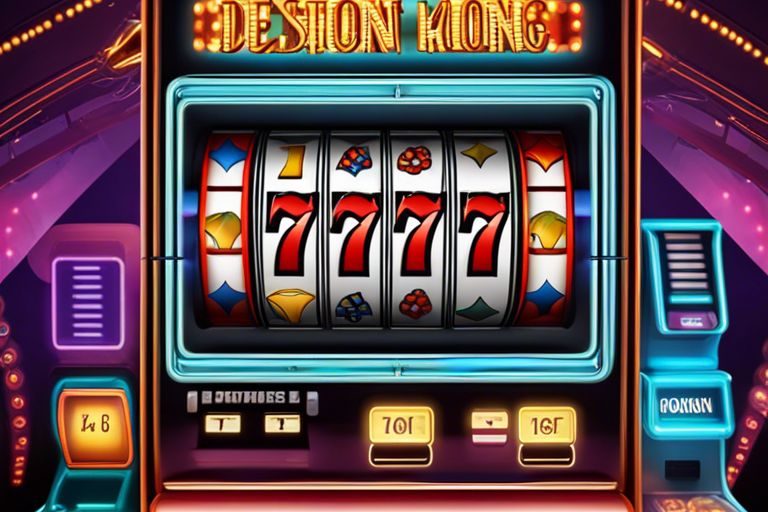The Psychology of Colors in Slot Game Design

You may not realize it, but the #colors used in #slotgames are strategically selected to evoke specific emotions and reactions from #players. Colors have a profound impact on human behavior and can significantly influence decision-making, mood, and engagement levels. Game #designers pay careful attention to the color schemes they incorporate into their designs because they understand the powerful effect colors can have on the player's overall #gaming experience.
Basic Principles of Color Psychology
Historical Context of Color in Human Culture
Principles of color psychology have roots deep in the history of human culture. Since ancient times, colors have played a crucial role in various aspects of human life, including art, religion, and healing practices. Different civilizations attached specific meanings to colors based on their observations and beliefs. For instance, in ancient Egypt, the color blue was associated with the sky and the Nile River, representing life and fertility. Understanding the historical significance of colors provides valuable insights into how they continue to influence our perceptions and emotions today.
Color Theory and Emotion: An Overview
Principles of color psychology are deeply intertwined with color theory, which explores how different colors evoke specific emotional responses in individuals. The relationship between color and emotion is complex and multifaceted, with each color carrying its own set of meanings and associations. For example, red is often linked to energy, passion, and excitement, while blue is associated with calmness, trust, and serenity. By understanding the basic principles of color theory and emotion, designers can strategically utilize colors in slot game design to create the desired psychological effects on players.
Color choices in slot game design can significantly impact the player's gaming experience and perception of the game. Warm colors like yellow and orange can create a sense of excitement and urgency, while cool colors like green and purple may evoke feelings of relaxation and mystery. By carefully selecting and combining colors, game developers can enhance the overall gameplay experience and influence player behavior in subtle but powerful ways.
Color Schemes in Slot Games
Even though slot games are primarily designed for entertainment purposes, the use of colors in their design plays a crucial role in creating an engaging and immersive experience for players. The color schemes chosen can influence a player's mood, emotions, and overall gaming experience. Understanding the psychology behind different color palettes is imperative for game developers to design captivating slot games.
Common Color Palettes and Their Impact
Common color palettes used in slot games include vibrant and high-energy schemes like reds, yellows, and oranges, which can evoke feelings of excitement, energy, and urgency in players. On the other hand, cool and calming color palettes such as blues, greens, and purples are often used to create a more relaxed and soothing gaming environment. Neutral color schemes like whites, grays, and blacks are commonly employed to convey a sense of sophistication and elegance in slot game design. By carefully selecting a color palette, game developers can effectively influence player engagement and enhance the overall gaming experience.
Color Trends in Modern Slot Games
Even in the dynamic world of slot game design, color trends play a significant role in shaping player preferences and expectations. In modern slot games, we see a shift towards bold and eye-catching color combinations that aim to grab players' attention and create a visually stunning experience. Additionally, designers are experimenting with unique color gradients, neon hues, and metallic accents to add a touch of modernity and dynamism to slot game visuals. By staying ahead of color trends and incorporating innovative color schemes, game developers can effectively attract and retain players in a competitive market.
Player Engagement and Color Choices
Enhancing Player Experience through Color
Color plays a crucial role in slot game design, especially when it comes to engaging players. Colors can evoke emotions, create atmosphere, and influence behavior. Game developers strategically use color palettes to enhance the player experience and make the gameplay more immersive. Bright and vibrant colors are often used to grab the player's attention, while soothing colors can create a sense of relaxation. By carefully selecting colors, game designers can evoke certain moods and keep players engaged for longer periods.
Color Influence on Player's Decision-Making
With respect to player decision-making in slot games, choices of colors can have a significant impact. Studies have shown that certain colors can affect cognitive processes and even influence players' decisions. For example, red is often associated with excitement and intensity, which can encourage players to take risks. On the other hand, blue is calming and can promote a sense of trust and reliability. Game developers strategically use these color theories to guide players' decisions within the game.
Through the use of color psychology, game designers can subtly influence players' behavior and create a more enjoyable gaming experience. By understanding how different colors can impact emotions and decision-making, developers can effectively design slot games that keep players engaged and entertained.
The Role of Color in Game Branding
Brand Identity and Color Consistency
Many successful slot game developers understand the importance of branding and how color plays a vital role in creating a strong brand identity. Consistency in color choices across various elements of a game, from the logo to the user interface, is crucial for brand recognition. When players see these consistent colors, they are more likely to associate them with a specific game and developer.
Color and Player Loyalty
An intriguing aspect of color psychology in slot games is its ability to influence player loyalty. Research has shown that players tend to be drawn to games that use colors associated with positive emotions, such as red for excitement and blue for trust. Game developers can leverage this by incorporating these colors strategically in their designs to enhance player engagement and build strong connections with their audience.
Plus, using consistent colors in branding can also help establish trust and credibility with players. When players see a game with a familiar color scheme, they are more likely to perceive it as reputable and reliable. This can lead to increased player loyalty and retention, ultimately benefiting the long-term success of the game.
Colors and the Perception of Winning Odds
Colors Associated with Luck and Winning
Perception: Colors play a crucial role in the way players perceive their winning odds in slot games. Certain colors are commonly associated with luck and winning, leading players to feel more optimistic and confident while playing. For example, shades of red and gold are often linked to prosperity and good fortune in many cultures, making them popular choices in slot game design. These colors can create a sense of excitement and positivity, influencing players to believe that they have higher chances of hitting a winning combination.
Psychological Impact of Colors on Risk-Taking Behavior
Behavior: The psychological impact of colors on risk-taking behavior is a key factor in slot game design. Colors can evoke different emotions and behaviors in players, ultimately affecting their willingness to take risks. For instance, red is often associated with energy, passion, and excitement, which can lead players to feel more adventurous and inclined to take bigger risks. On the other hand, blue is linked to calmness and stability, which may make players more cautious and risk-averse.
Understanding how colors influence risk-taking behavior can help game developers create more engaging and immersive experiences for players. By strategically using colors in slot game design, developers can effectively manipulate players' perception of winning odds and encourage desired behaviors.
Color Accessibility in Game Design
After deciding on the color scheme for a slot game, it is crucial to consider color accessibility in game design. This involves ensuring that the colors chosen for the user interface are easily distinguishable by all players, including those with color vision deficiencies.
Designing for Color Vision Deficiencies
Designing with color vision deficiencies in mind means selecting colors that have high contrast and can be easily differentiated by individuals with various types of color blindness. It is important to avoid color combinations that may be confusing for those with color vision deficiencies, such as red and green, as they are commonly difficult to distinguish for some individuals.
The Importance of Contrast and Color Balance
One necessary aspect of slot game design is ensuring a good balance of color and contrast. Proper contrast not only makes the game visually appealing but also improves usability and accessibility for all players. By carefully choosing colors that stand out against each other, developers can create a visually engaging experience that is easy on the eyes.
Game designers should pay attention to the color balance within the game to prevent eye strain and fatigue. Bright, clashing colors can be overwhelming and may detract from the overall gaming experience. Striking a balance between vibrant colors and soothing tones is key to keeping players engaged without causing visual discomfort.
Future Trends in Color and Slot Game Design
Innovation in Color Use as Technology Progresses
All industry experts and game designers are constantly exploring ways to revolutionize slot game design. Future trends indicate a significant focus on innovation in color use as technology progresses. With advancements in display technologies and graphics capabilities, game developers are presented with new opportunities to push the boundaries of creativity in color incorporation. One exciting possibility is the integration of dynamic color schemes that interact with gameplay elements in real-time, enhancing the overall gaming experience for players.
Anticipated Shifts in Player Preferences
On the horizon are anticipated shifts in player preferences when it comes to color usage in slot game design. As the industry evolves, players are becoming more discerning and sophisticated in their expectations, seeking immersive experiences that go beyond traditional color palettes. The future of slot game design will likely see a move towards personalized color schemes that cater to individual player preferences and enhance engagement.
The increasing demand for customization in slot games may lead to the development of innovative tools that allow players to choose their color themes or tailor the visual aspects of the game to their liking. This shift in player preferences emphasizes the importance of flexibility and adaptability in color usage within slot game design, encouraging designers to think outside the box to meet the evolving needs of their audience.
Final Words
Summing up, the psychology of colors plays a crucial role in slot game design, influencing players' emotions, perceptions, and behaviors. By strategically selecting colors based on their psychological effects and associations, game developers can create immersive and engaging experiences that resonate with players on a subconscious level.
Understanding how different colors affect players can help designers evoke specific moods, guide attention, and enhance gameplay. By harnessing the power of colors, slot game developers can create visually captivating and psychologically compelling experiences that keep players coming back for more.
FAQs
How do colors impact player engagement in slot games?
Colors can significantly affect player engagement by evoking specific emotions and creating an immersive atmosphere. For example, vibrant colors like red and yellow can create excitement, while cool tones like blue and green can induce relaxation. Game developers use these color schemes to enhance the overall gaming experience and keep players interested.
What is the role of color psychology in slot game design?
Color psychology plays a crucial role in slot game design by influencing players' emotions, decision-making, and overall experience. Designers use color theory to evoke desired emotional responses, such as excitement or calmness, and to impact players' behavior, such as risk-taking and engagement.
How does color theory relate to player behavior in slot games?
Color theory explains how different colors evoke specific emotional responses, which can affect player behavior. For example, red may stimulate excitement and risk-taking, while blue can promote a sense of calm and trust. Understanding these effects helps designers create engaging and effective game environments.
Why is color consistency important for slot game branding?
Consistency in color use across a game's branding elements helps establish a strong brand identity and improves brand recognition. Consistent color schemes make games easily recognizable and can enhance player loyalty by creating a sense of familiarity and trust.
How can game developers ensure color accessibility in slot games?
To ensure color accessibility, game developers should choose high-contrast color combinations and avoid problematic color pairs, such as red and green, which can be difficult for individuals with color vision deficiencies to distinguish. Proper contrast and color balance improve usability and make the game enjoyable for all players.
Recommended Posts

Hidden Treasures of Rome Slot by Swintt
October 4, 2024

Gold of Egypt Slot by Silverback Gaming
October 4, 2024

Lady of Fortune Remastered Slot by Play’n GO
October 3, 2024



